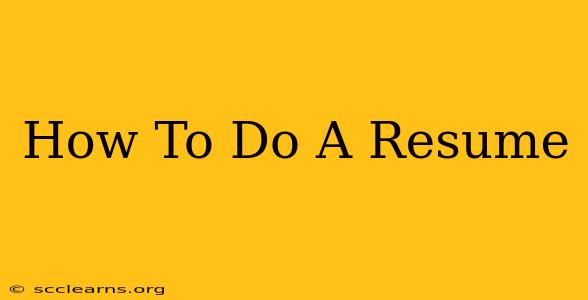Creating a compelling resume can feel daunting, but it doesn't have to be. This comprehensive guide will walk you through each step, ensuring your resume stands out from the competition and lands you those all-important interviews. We'll cover everything from choosing the right format to highlighting your skills and achievements.
1. Choosing the Right Resume Format
Before you even begin writing, you need to select the appropriate resume format. The best choice depends on your experience level and the type of job you're applying for.
a) Chronological Resume:
This is the most common format, ideal for candidates with a consistent work history. It lists your work experience in reverse chronological order, starting with your most recent job. This format emphasizes career progression and stability. Use this if: You have a strong, consistent work history and want to highlight your career trajectory.
b) Functional Resume:
This format focuses on your skills and abilities rather than your work history. It's best for career changers, individuals with gaps in their employment history, or those with limited work experience. Use this if: You're changing careers, have gaps in your employment, or want to emphasize specific skills over chronological work experience.
c) Combination Resume:
This combines elements of both chronological and functional resumes. It highlights your skills upfront, followed by a chronological listing of your work experience. This is a versatile option suitable for many situations. Use this if: You want to showcase both your skills and your work experience.
2. Crafting Your Resume Sections
Once you've chosen your format, it's time to craft the individual sections of your resume.
a) Contact Information:
This is crucial! Include your full name (make it stand out!), phone number, email address, and optionally, your LinkedIn profile URL. Keep it concise and professional. Avoid: using unprofessional email addresses or including irrelevant information.
b) Summary/Objective (Optional):
A strong summary or objective statement can make a big difference. A summary is best for experienced professionals, highlighting key accomplishments and skills. An objective is better for entry-level candidates, stating career goals. Tailor this section to each job application. Focus on: keywords relevant to the job description.
c) Skills:
Showcase your relevant hard and soft skills. Use keywords from the job description whenever possible. Categorize your skills for better readability. Examples: Proficiency in Microsoft Office Suite, project management, communication, teamwork.
d) Work Experience:
This is the core of your resume. For each role, use the PAR (Problem-Action-Result) method to describe your accomplishments. Quantify your achievements whenever possible (e.g., "Increased sales by 15%"). Focus on: achievements and contributions, not just duties.
e) Education:
List your degrees, certifications, and relevant coursework. Include your GPA if it's above 3.5. Highlight: relevant academic achievements, such as Dean's List or scholarships.
3. Tips for a Standout Resume
- Use Keywords: Incorporate keywords from the job description throughout your resume.
- Quantify Your Achievements: Use numbers and data to demonstrate your impact.
- Proofread Carefully: Errors are a major turn-off. Have someone else proofread your resume before submitting it.
- Tailor Your Resume: Customize your resume for each job application.
- Keep it Concise: Aim for one page if possible, especially for entry-level positions.
- Use a Professional Font and Layout: Choose a clean, easy-to-read font like Times New Roman, Arial, or Calibri.
4. Beyond the Resume: The Importance of Cover Letters
While this guide focuses on resume creation, remember that a strong cover letter is often crucial. Your cover letter allows you to expand on your resume and showcase your personality and enthusiasm for the position. Make sure your cover letter complements your resume and further highlights your key qualifications.
By following these steps and paying close attention to detail, you can create a resume that effectively showcases your skills and experience, leading you one step closer to landing your dream job. Remember, your resume is your first impression – make it count!

